The Electronic Intifada 2 January 2018

Relatives of Palestinian boy Ahmad Abu Abid, 4, mourn during the child’s funeral in Khan Younis, southern Gaza, on 12 December. The child succumbed to injuries sustained days earlier after he was hit by shrapnel fired by Israeli soldiers during Great March of Return protests.
APA imagesIsraeli occupation forces killed 14 Palestinians in the West Bank and Gaza Strip in December.
It was the first month since the launch of the Great March of Return in March that more Palestinians were killed in the West Bank than the Gaza Strip.
Some 300 Palestinians were killed by Israeli soldiers and settlers throughout the year. Fourteen Israelis were killed by Palestinians during the same period, including two soldiers shot dead in the West Bank during December.
Additionally, a baby died days after his premature birth following the critical shooting of his Israeli mother near a West Bank settlement in December.
Salah Barghouti, a 29-year-old Palestinian, was alleged by Israel to have shot the woman whose baby died, along with her husband and five others who were moderately injured.
Forced disappearance
The Palestinian rights group Al-Haq made an urgent appeal to the UN Working Group on Enforced or Involuntary Disappearances concerning Barghouti’s case.
According to Al-Haq’s documentation, including witness testimony, Barghouti was apprehended alive on 12 December. Several hours after his disappearance, Israeli media reported that Barghouti had been killed by Yamam, a special unit of Israel’s Border Police.
The inconsistencies in Israel’s narrative concerning Barghouti, Al-Haq states, “reveal that there has been an attempt to conceal the circumstances in which [Barghouti] was arrested, detained and possibly killed, while they fail to disclose his current whereabouts.”
The day after Barghouti’s disappearance, Israeli forces killed Ashraf Naawla, 23, after a two-month manhunt. Naawla was suspected of shooting and killing two Israelis at a West Bank settlement industrial plant in early October.
Disabled man shot from behind
Also during December, Israeli forces shot Muhammad Habali, a 22-year-old Palestinian with cognitive and physical disabilities, in the head from behind at a distance of 80 meters during a raid on the city of Tulkarm.
“The lethal shooting was not preceded by a warning, was not justified and constitutes a violation of the law,” the Israeli rights group B’Tselem stated after its own investigation contradicted Israel’s claims that Habali was killed during a “violent disturbance of the peace.”
Omar Hassan al-Awawdeh, 27, was killed after he drove through a checkpoint without stopping and allegedly accelerated towards a Border Police combatant.
An investigation by the Israeli daily Haaretz found that al-Awawdeh was likely trying to evade being fined by Israeli forces for burning plastic when he was killed.
Also in the West Bank, 25-year-old Majd Jamal Mteir was killed after allegedly stabbing and lightly wounding two police officers in Jerusalem on 13 December.
That same day, Hamdan al-Arda, 58, was shot and killed by Israeli soldiers in the town of al-Bireh, adjacent to Ramallah, the seat of the Palestinian Authority in the West Bank. Israel claimed that al-Arda was killed as he attempted to attack soldiers with his car but doubt was soon cast on that narrative.
Teenagers killed
On 14 December, 18-year-old Mahmoud Nakhla was shot in the back by a soldier during a raid in Jalazone refugee camp, near Ramallah. Soldiers prevented Palestinian medics from providing treatment to the wounded teen, who died on the way to hospital.
And on 20 December, soldiers shot and killed Qasim Muhammad Ali al-Abbasi, 17, at a checkpoint near Ramallah, claiming they opened fire on a car that ran through a roadblock.
Surviving passengers in the car said that the group was attempting to reach the city Nablus when they realized they had accidentally turned onto a road leading to an Israeli settlement. When they tried to return to the main road, they came under heavy fire.
Two children were among six Palestinians killed in Gaza during December, all fatally wounded during Great March of Return protests, and among 56 Palestinian children killed by Israeli forces throughout the year.
Great March of Return fatalities
Ahmad Yasir Sabri Abid, 4 years old, was the youngest fatality yet during the Great March of Return after he was hit by shrapnel during protests on 7 December and died four days later.
Muhammad al-Jahjouh, 16, was shot in the neck and killed during Great March of Return protests along Gaza’s eastern perimeter on 21 December.
That same day, Israeli forces shot in the head and killed Maher Atiyya Muhammad Yassin, a 40-year-old man with physical disabilities resulting from polio, while Abd al-Aziz Abu Sharia, 28, died after being shot in the stomach. Ayman Munir Muhammad Shubeir, 18, died on 22 December after being shot in the stomach during protests the previous day.
Karam Muhammad Fayyad, 28, was shot in the head and killed during demonstrations on 28 December.
Fayyad, who had mental illness, according to the rights group Al Mezan, is among eight persons with disability killed during the Great March of Return protests, including one child.
Also among the Great March of Return fatalities, totaling 180 since 30 March, were 35 children, a woman, two journalists and three paramedics, according to Al Mezan.
More than 7,400 Palestinians have been wounded by live fire during the protests. Some 29,000 Palestinians in the West Bank and Gaza were wounded by Israeli forces during the year – the highest total since the UN Office for the Coordination of Humanitarian Affairs (OCHA) began collecting data in 2005.
Increase in settler violence, Gaza food insecurity
The UN monitoring group also documented a sharp uptick in Israeli settler attacks against Palestinians and their property during 2018, with a nearly 70 percent increase in incidents over the previous year, resulting in the death of a woman and the injury of 115 other Palestinians.
“Palestinian property vandalized by settlers includes some 7,900 trees and about 540 vehicles,” OCHA stated.
“There were at least 181 incidents where Palestinians killed or injured settlers and other Israeli civilians in the West Bank or damaged Israeli property, a 28 percent decline compared with the previous year,” OCHA added. “However, the number of Israelis killed in these incidents in 2018 (seven), increased compared to 2017 (four).”
The rate of food insecurity increased in Gaza to 68 percent of the population, up from 59 percent in 2014. The food insecurity rate in Gaza, under Israeli air, sea and land blockade since 2007, was nearly six times that in the West Bank, where the rate has fallen since 2014.
The World Food Programme is slashing food aid to Palestinians in 2019 due to a shortage of funds, affecting 27,000 people in the West Bank and 165,000 people in Gaza. The US government slashed half a billion dollars in foreign aid to Palestinians, including refugees in Syria, Lebanon and Jordan, during 2018.
Eight Palestinians in Syria were recorded during the month of December as having died as a result of the ongoing war in the country.
Five residents of Yarmouk refugee camp, including two sets of brothers, were recorded as having died in Syrian government detention.
Three other Palestinians in Syria died in battle alongside government forces during the month.
Nearly 4,000 Palestinians in Syria have died as a result of the war since 2011, according to the Action Group for Palestinians in Syria. More than 560 of those fatalities are Palestinians who died in Syrian government prison and detention centers, and some 200 who have died as a result of the siege on Yarmouk camp.
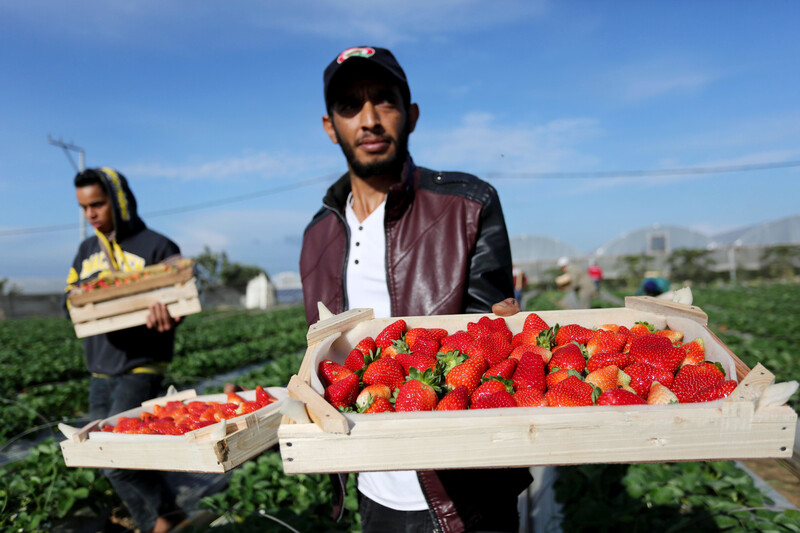
Palestinians harvest strawberries at a farm in Beit Lahiya, northern Gaza Strip, on 1 December.
APA images
Palestinians in the West Bank city of Nablus march in solidarity with Jerusalem on 2 December. The banner reads “Jerusalem is Arab and the capital of the state of Palestine. Jerusalem is the key to war and the key to peace.”
ActiveStills
A Palestinian woman makes traditional taboun bread in Salem village, east of the West Bank City of Nablus, on 3 December.
APA images
An injured protester is treated by paramedics during Great March of Return protests east of al-Bureij, central Gaza, on 7 December.
APA images
Imad al-Din al-Saftawi is greeted by family and friends upon his release in Gaza City on 12 December after spending 18 years in Israeli prison.
APA images
Israeli settlers block a road where two Israeli soldiers were killed an hour earlier, near the Givat Assaf settlement in the occupied West Bank, on 13 December. Israeli settlers rioted across the West Bank after attacks by Palestinians over the previous week.
ActiveStills
Palestinians confront Israeli forces near the settlement of Beit El on 14 December during a military crackdown on the Ramallah area of the occupied West Bank following the killing of two soldiers.
APA images
A woman shields her husband from Palestinian Authority security forces as the latter violently disperse a demonstration in the West Bank city of Nablus on 14 December.
APA images
A Palestinian protester throws back a tear gas canister shot by Israeli soldiers during Great March of Return protests east of Gaza City on 14 December.
ActiveStills
Relatives of Mahmoud Nakhla, 18, mourn during the teen’s funeral in Jalazone refugee camp, near the West Bank city of Ramallah, on 15 December. Nakhla was shot dead by Israeli forces during a raid on the camp the previous day.
APA images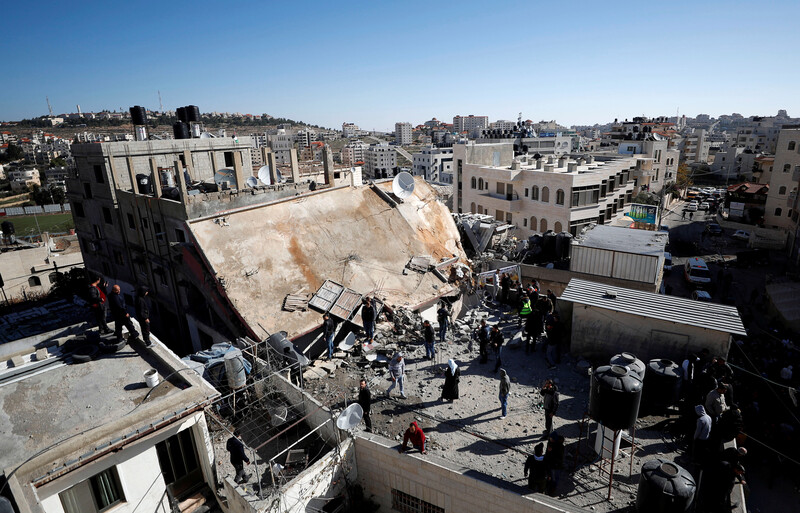
A home belonging to the Abu Humaid family in al-Amari refugee camp near the West Bank city of Ramallah after it was blown up by Israeli forces on 15 December. Israeli forces destroyed the home belonging to an elderly widow in an act of collective punishment after her son was alleged to have pushed a marble slab from the rooftop onto an Israeli soldier during a raid, causing him fatal injury.
Reuters
Fireworks are set off during a Christmas tree lighting ceremony in Jerusalem’s Old City on 15 December.
APA images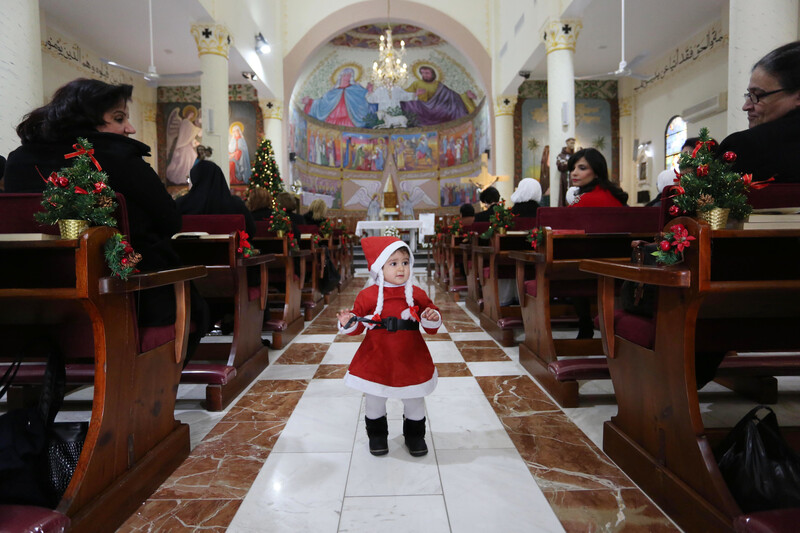
Palestinian worshippers wait for the acting Latin Patriarch of Jerusalem to lead mass at the Holy Family Church in Gaza City on 16 December.
APA images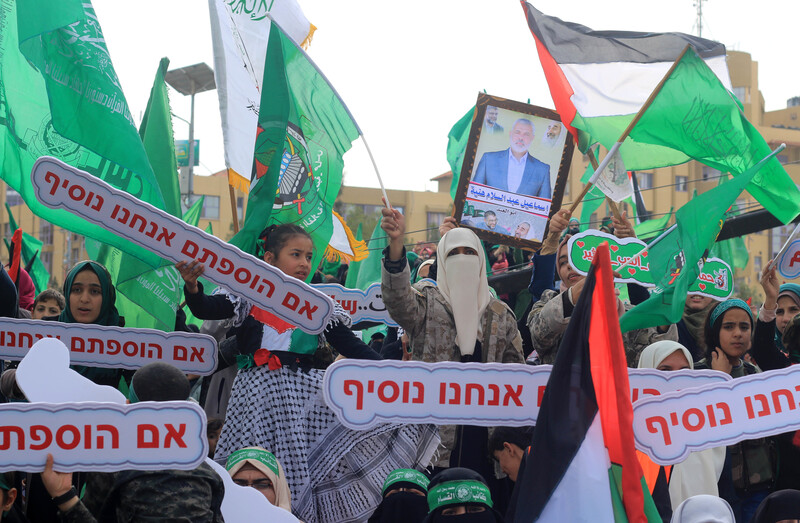
Hamas supporters in Gaza City mark the 31st anniversary of the founding of the Islamist movement on 16 December.
APA images
Palestinians hold a weekly sit-in in solidarity with Palestinian prisoners held by Israel in front of the Red Cross offices in Gaza City on 17 December.
APA images
A Palestinian man inspects the ruins of the destroyed home belonging to the family of Ashraf Naalwa in Shweika, near the West Bank town of Tulkarm, on 17 December. The demolition was carried out as a measure of collective punishment after Naalwa allegedly killed two Israelis at a West Bank industrial plant in October. Naalwa was killed by Israeli forces after a two-month manhunt on 13 December.
ActiveStills
Photojournalist Mohammed Asad displays his camera that was damaged by shrapnel while covering protests east of Gaza City on 21 December. The camera was hit by shrapnel from the same bullet that killed 16-year-old Muhammad al-Jahjouh.
APA images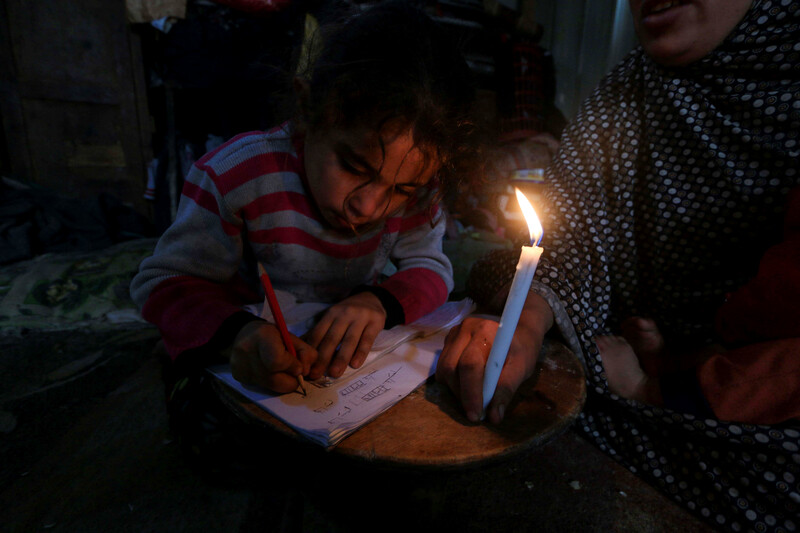
A Palestinian girl does homework by candlelight at her family’s dwelling at Nahr al-Bared encampment in Khan Younis, southern Gaza Strip, on 20 December.
APA images
Mourners carry the body of Ayman Shubeir, 18, shot dead by Israeli forces during Great March of Return protests, during his funeral in Deir al-Balah, central Gaza Strip, on 22 December.
APA images
A Blackstart perches on a branch in the West Bank town of Tubas on 23 December. The flycatcher is found in desert regions in North Africa, the Middle East and the Arabian Peninsula.
APA images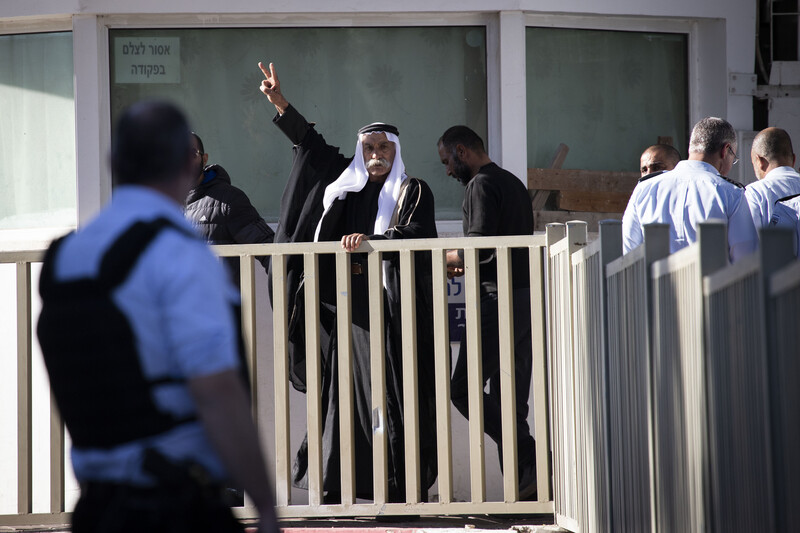
Sheikh Sayah al-Turi, the head of al-Araqib village, walks into Maasiyahu Prison, in the city of Ramle in central Israel, on 25 December to serve a 10-month prison sentence after he was convicted of unlawfully entering and trespassing on land where his village once stood. Al-Araqib, is not formally recognized by the state and has been demolished more than 100 times in the past several years.
ActiveStills
Artist and calligrapher Hashem Kalloub, 59, at his Gaza City workshop on 26 December.
APA images
Palestinians attend a ceremony marking the National Day of Martyrs organized by Gaza’s Ministry of Interior and National Security to mark the 10th anniversary of the Israeli military assault on Gaza dubbed Operation Cast Lead, on 27 December. Some 250 members of Gaza’s police force were among the approximately 1,400 Palestinians killed during the three-week offensive.
APA images
Relatives of Elias Salih Yassin, 22, mourn during the young man’s funeral in the West Bank town of Salfit on 29 December. Yassin was shot and fatally wounded by Israeli forces while allegedly attempting to carry out a stabbing attack in the West Bank on 15 October; Israel withheld his body until late December.
APA images
Palestinian Authority leader Mahmoud Abbas speaks during a ceremony marking the 54th anniversary of the Fatah party’s founding, in the West Bank city of Ramallah, on 31 December.
APA images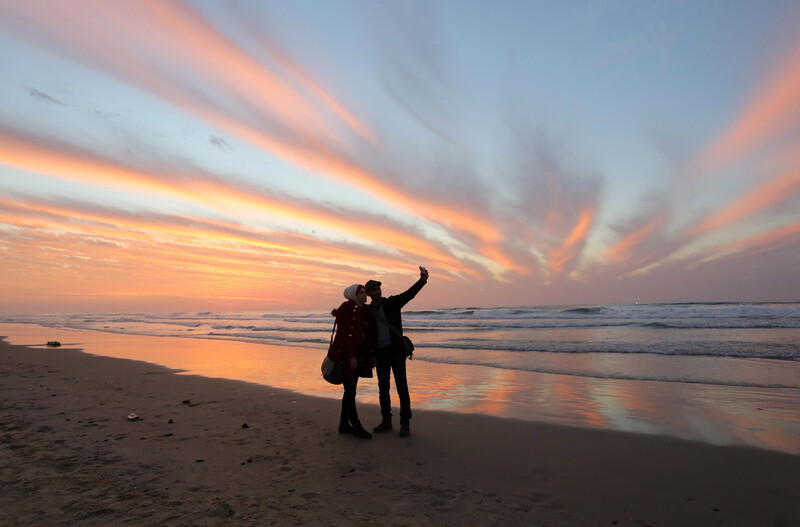
Palestinians enjoy the last hours of 2018 on the beach in Gaza City on 31 December.
APA images

